





Follow this link for other pests and diseases of Aquilegia Scroll down a little, or use this link to IN A NUTSHELL If you are reading this as early, new growth appears, visit the webpage in signs to look for in spring, and the other main page is likely to be how to look for the subtle yellowy patches on leaves which may be the very first sign in your garden.
Grateful thanks to the RHS Members' Advisory Service, and other plant pathologists, especially Nigel Stringer (volunteer at National Botanic Garden of Wales). In particular much of the scientific information that I quote, particularly concerning fungal diseases, is from these two main sources. This Fera DM information sheet is also a good general source of information about downy mildews in general, and also visit the RHS DM profile, and the RHS now also have an Aquilegia DM page.
When my aquilegias were infected, there was no published information about downy mildew (DM) of aquilegias. These webpage is to inform and help you prevent, identify and cope with infections. It is a work in progress. Please tell me of any mistakes as well as other ideas, information and stories about how this has affected your plants and how you have dealt with it. Also you can add to where it is found in the UK and worldwide. Even failure of preventative and treatment methods is useful knowledge; as well as what has seemed to work; and why you think that is so.
I am self-funding, working on ADM research here, supporting others' research, giving a personal advice service, inspecting open gardens and reporting back findings of ADM, and paying for these webpages. If you find these pages helpful, will you please consider helping with a donation? It is easy to support in this way with a debit/credit card through the secure Paypal site. This first button allows donations from just 75p up to £15, and the second button is for larger amounts.
TOUCHWOOD AQUILEGIAS, my story, Dec 2014: My aquilegias were first seen to be affected in 2014. I had no idea what was affecting some of my plants as they started into growth in the spring, until both Nigel Stringer and the RHS Members' Advisory Service identified the pathogen for me (on the same day!). The RHS had had enquiries about it in the previous year (2013) seasons and Fera for probably 2 years before that (having already bar-coded the DM genome). But I had not heard of it at all. I still have not seen anything written about it except that which plant pathologists have told me. I now see that I had some infected plants at least 1 year earlier, but had no reason to believe that a sickly-looking aquilegia plant had a virulent infection of any sort, let alone one likely to lead to the death of the plant after efficiently infecting other plants around it, as well as creating the long term issue of resistant, infective spores in the soil. Why did I not take a sickly plant seriously, especially as I am a biologist, and someone who works with health in people? Mainly it was that I 'knew' there were no terminal pathogens for aquilegias: my plant losses I have generally put down to unsuitable (mild, wet) garden conditions. Also, I garden mainly organically and, with a particular interest in the smaller wildlife of the garden and soils, apply liberal doses of interest and tolerance to almost any pest and diseases seen. However a kindly blind eye was the worst thing I could have done with downy mildew. I do not know if my collections will survive (summer, 2015, no, they havn't). I do not know if I will ever be able to easily grow aquilegias in this soil again. I hope you discover this page BEFORE you have any problems, so you can nip it in the bud.
Suggested control measures are featured in blue on this webpage. I'm hoping that nationwide prevention will be helped by providing this by information, thus leading to early identification. Immediate removal of any plant even suspected of having the disease, may be the only effective solution. Unless we can report something more hopeful via these pages in the future. Please return, there is more research being done.
If your plants are infected, or you suspect that they may be, then email me with details and photo (if possible) as well as your county and town as I am compiling a directory of where downy mildew of Aquilegias has been found so far.
Aquilegia DOWNY MILDEWIn a nutshell. Follow the photo-links for further information about symptoms. |
||
| SIGNS to LOOK FOR: Link for images of the yellowy mottling / patches and comparison with variegated leaves. NOTE: Downy mildew of aquilegias is NOT caught from downy mildew on other plants, eg Busy Lizzies. |
Lighter, yellowy patches on the leaves, delineated by leaf
veins. Note, often very subtle. Distinctly unlike variegated leaves: * in downy mildew the colour differences between green and yellow is less strong. * follows leaf veins so often has straight edges rather than splashed variegated effect. * is not present at germination. Control infection by picking off all infected leaves, or, if as badly affected as this plant, digging it all out and discarding I(NOT onto the compost heap) |
.jpg) |
| This is the upper surface of the same leaf as on the right,
showing how much more subtle is the yellowy patches from the
underneath of the leaf. |
Initially there is little signs of infection on the lower
leaf surface, and the variegated effect is very subdued from the
underside of the leaf. Here's close-up.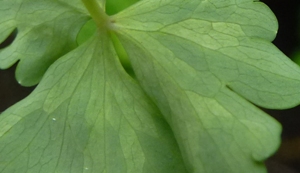 What is happening is that the mildew is growing INSIDE the leaf spaces, and into the cells within the leaf, so unlike powdery mildew, nothing is visible on the leaf surfaces. There is no known effective chemical control of DM for home gardeners. |
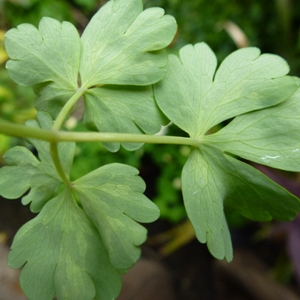 |
Link for more images showing the tops and undersides of affected leaves Although this is the defining sign of downy mildew, it is not always present. It is only produced under the correct moist conditions, and easily flattened out by rain (think of a fluffy thistledown resting on a leaf before, then after, rain!) 2015, I had such downiness from February in some plants. |
Under warm moist conditions, the mildew grows out through
the stomata (breathing pores) of the leaf. Spore production
probably only takes place during twilight or at night. You can then see the growth as fluffy white (downy) growth on the under-surface of the leaf. You will probably need the help of a hand lens or magnifying glass. Hint: keeping leaves that are NOT yet showing any external growth in a plastic bag with a wet tissue for a time, may encourage growth that you can see. Or rot the leaf. Hint 2: 'older', wettened, growth may no longer look fluffy, imagine the difference between dry and wet cotton wool. Difficult to see. Hint 3: Use a camera with macro for a close-up photo, then view at magnification on your computer screen. |
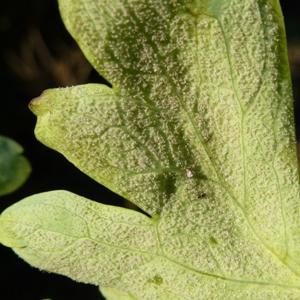 |
Link for general downy mildew lifecycle on grape, as aquilegia DM has not yet been investigated and published. |
The mildew produces sporangia which shed millions of tiny,
asexual spores that will drift onto other leaves...and germinate
and grow through a stoma (pore) to infect that leaf. Spore germination and growth on the leaf surface requires moisture, but that isn't necessary once it is growing inside the leaf. Thank you to RHS Horticultural Science for the photomicrograph of the Aquilegia Downy Mildew. |
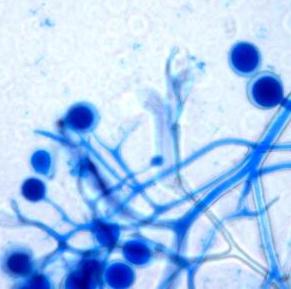 |
| Besides these (probably) shortish-lived spores, other types
of spores may last 2-3 years in the soil. Or 10-20 years,
we just don't know. These are known as oospores or resting
spores. Rain can splash these spores onto leaves to start the infection. Where there has been infection, then mulching with unaffected soil/compost /growing media or even grass clippings may help prevent or minimise infection. |
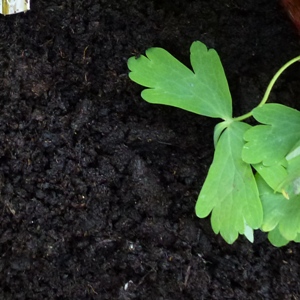 |
|
| Wet leaves encourage spores to grow. So rain, fog/mist and dew all encourage moistness, especially where there is no drying wind. Dry conditions will prevent sporulation and minimise spread. Here in Wales leaves may remain wet for days or even weeks. Warmth is also necessary. Speed of growth of the fungal hyphae is directly related to temperature. So in wet summers DM grows and spreads quicker than in cooler times such as wet early springs or late autumns. Try and keep up with hand-picking all infected leaves, but certainly make a concerted effort before rain is forecast. |
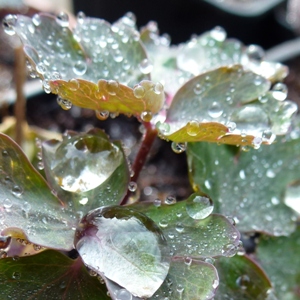 |
|
|
|
You may find silvery trails from slug/snail (molluscs / gastropods), or even partially eaten leaves. Why? Surely aquilegias are so poisonous that they are slug proof? Yes, but in this case it is the fungal mycelium that proves irresistible, and a good, nourishing food source for the gastropods. |
|
Leaf lamina (tissue) start to die away. Brown, dead tissue enlarges into holes until large pieces of leaf lamina are missing. The plant responds to minimise the deleterious effect of infection by cells dying in the area (programmed cell death). It is probable that cell contents are broken down and the resulting nutrients transported away in the phloem. As downy mildew is a new disease, aquilegias do not seem to have effective resistances, or chemical controls through effective antibiotic production. Hence whole plants die. |
|
|
Follow the link above to see the role of oospores in the DM lifecycle. Here is another diagram, this time of DM in lettuce. By now you should have an appreciation of the complexity of the life cycles of mildews. |
Eventually all leaf lamina disintegrates away, leaving (often fairly healthy-looking) leaf stems (petioles). The response of the DM to dying plant tissue is probably to produce sexual oospores, which fall to the soil as the leaf disintegrates. These are more-resistant spores and these are the ones that can be long-lived in the soil, possibly 2-3 years. Or, up to 25 year, perhaps like some other downy mildews. |
|
| STEMS | What's happening to the stems of the plants? Well, the only stems that aquilegias have are flowering stems, growing from April/May. These may become infected by DM growing into the outer layer of the stem (epidermis). Bad infections may show as reddish-brown discoloured patches (lesions). |
|
There can also be secondary damage due to grazing gastropods (slugs & snails) drawn in by the nutritious fungal material. |
|
|
|
|
Infection by DM in the stem and / or the effect of snail damage can give rise to distinctive, distorted, kinky stems. Why does downy mildew itself cause distortion? I wonder if it is because infection alters the usual geotropic (& / or phototropic) response of the stem? |
|
The cauline (stem) leaves may show the same signs as ordinary leaves. |
|
|
|
|
After rain with winds, flower buds may look 'blasted' as if by very cold weather. When I first saw this I thought it looked 'blighted', even though I had no real understanding of the term. However it seems that that intuitive description holds a lot of truth, as downy mildew has more in common with blights (eg potato) than with, eg, powdery mildew. And thrives under the same conditions as potato blight. Under continuing suitably warm, moist conditions they will go mouldy, showing the white downiness. Though this may also be a secondary infection with another fungal disease. Link for more images of flowers affected by downy mildew. |
|
| EFFECT ON DEVELOPING SEED PODS | Even if the flowers themselves are fine, sometimes the developing seed pods can become infected. The browning effect is subtly different from the natural browning of the seedpod as it dries ready to open in order to disperse seeds. With DM affecting the pods, could the developing seed carry infection? |
|
| EFFECT ON SEED PRODUCTION When you sow any seeds, keep a close eye on any seedlings, for signs of yellowy angular patches, or whitish, upright, systemically infected growth, with longer petioles to leaf-surface area. Visit the DM on seedlings page for further information. |
The fertilised ova inside the seedpods have failed to develop at all, due to the DM infection. Downy mildew transmission via seeds is unlikely to be an issue, especially as infection in the seed pod will abort seed production. However, the RHS has found DM DNA in seed samples from infected seedpods. This could be contamination from infected pods, including spores, on the seed-cases. If there are oospores present, there is a theoretical risk of them infecting the emerging seedlings. Or, a worst-case scenario, it could be infection within the seed itself, in which case the seedlings could grow already systemically infected with DM. |
|
|
|
HOWEVER, some infected seedpods do manage to ripen a few
seeds. In theory, it may be that spores could be on the seed surface. To be absolutely safe, I suggest a 'just in case' approach. If any germinating seeds show fungal infection, wilting and death, it is likely to be a case of Pythium (damping off) infection. Just in case it could be DM, then ensure the pot, growing media and any remaining seeds in there, are disposed of. If typical lightish yellowy, angular areas appear on small seedlings' leaves, or whiter, upright growth of systemically infected seedlings, again get rid of the whole potful. Please let me know if you suspect DM in your seedlings (either self-sown ones or in pots), especially if you can take photos. |
|
| WHAT DOES A WHOLE INFECTED PLANT LOOK LIKE? Link for more DM infected plants which includes photos over time. |
Very sick. To the right are 2 plants of Spring Magic, one healthy and one affected by downy mildew. |
|
| INFECTION OF WHOLE LEAF My theory is MERISTEM INFECTION Aquilegias do not have a 'stem', instead the leaves are produced at ground level in the 'nose' of the shoot. Areas that produce new growth (such as leaves and stems) are called meristems. Sometimes, instead of patches on the leaf lamina, the whole of a new leaf is infected. All tissue is infected, so at this point it is a systemic disease. Surprisingly, the colour is a whitish, lightish green rather than yellowy. |
These leaves are systemically-infected
as soon as they grow. I postulate that the meristem itself has
become infected. Alternatively, the nose of the shoot is a little like a funnel of leaf stems, an ideal 'trap' for spores (and moisture) to linger, and lead to immediate infection as the new leaf is formed. |
|
Such systemically infected leaves also will loose their lamina as the disease progresses, typically from the edges inwards rather than in patches.. |
|
|
|
Link to more systemically infected plants, and suggested action. And link to checking if your plants are infected as they emerge in spring. |
These new leaves also have a particularly upright and
frazzled appearance, coupled with what seems to be a smaller
leaf area compared to leaf stem, making them look drawn or
leggy. The light colour and legginess makes them look as if they are etiolated plants (suffering from a lack of light, such as when something grows under an upturned pot or bucket). |
|
|
|
The frazzled effect in part is
due to either upturning, or downturning, of leaf margins. With the legginess, this frazzled appearance is slightly reminiscent of a plant that has suffered a drift of chemical weedkiller on it. |
|
The smaller leaf area also gives a more 'lacy' or 'maidenhair ferny' effect, so the leaf superficially looks more triternate than the usual aquilegia leaf. |
|
|
| Link to results of leaf removal at this stage of DM infection. | At this stage I am also experimenting as to whether leaf removal may help to control the disease. |
|
However, it is probably best to dig out and remove such badly affected plants. See below on what to do with infected tissue. It may prove to be the only effective thing to do. |
|
|
| Other controls | In badly affected plants, that you hope
to save, it can be quicker to cut all stems
and leaves back to ground level, especially after flowering.
Then mulch with unaffected dressing. In the pic below you can see that I've cut back all the aquilegias in this bed, just after flowering, as a general way of minimising any possible infection. |
|
|
|
Besides removal of infected leaves, bear in mind that stems bearing seed pods could be infected. It is best to cut or break the stem close to the ground. With plants that you know have seed-pod infection it is probably best to remove whole flower / seed-pod stems as soon as possible. In seemingly unaffected plants, remove seed-pod stems, before or after seed dispersal, depending on whether or not you wish the plants to self-seed. |
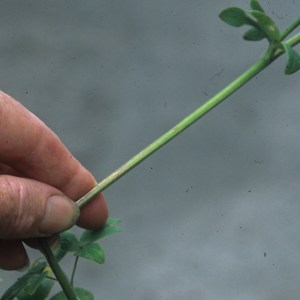 |
| To slow the spread of DM, place your
aquilegia plants as far apart as practicable, this will also
help air-flow and drying of moisture on leaves. Not like my usual nursery rows, for instance! |
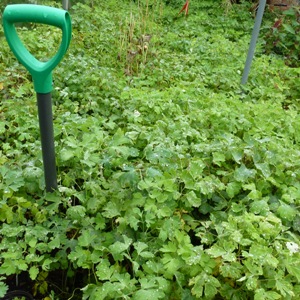 |
|
| My worst affected area was in my front garden. From
February, I had a wonderful display of hellebores, then, as
usual, went around tying up the hellebore foliage to give all
other plants in the garden more space. That's when I thought
'Where are my aquilegias?'. Usually by then they are well above
the Lenten rose foliage and starting to send up flowering
shoots. I discovered dead plants and systemically infected,
distorted and weak growth on many of these plants. So... Keep aquilegias away from dense, close plantings of other plants that effectively hold moisture around and on the aquilegia leaves. And keep weeded, for the same reason. |
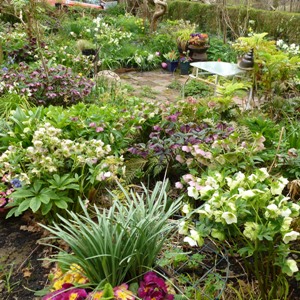 |
|
At the start of winter, as plants have naturally died back, cut away remaining leaves (including their leaf stems) as well as any 'fallen' leaves. These leaf remains could contain oospores. Mulching just before plants come into growth may help prevent spores being splashed onto new leaves. Remember though, that aquilegia plants won't want their noses buried in a mulch. |
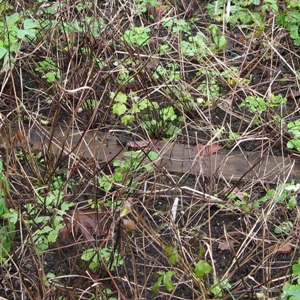 |
|
| Help others ...and stay informed yourself Here's where I hear it is so far: Directory of where DM is found. |
Please share your experiences. email me with your experiences, especially for what works for you. Got any photos? You can also keep informed and tell others via the Facebook Aquilegia Fans page, or join the Aquilegiachatlist email group. It is not known how serious this disease will become. It could well be the end of the Touchwood collections. Perhaps not. What is needed is early discovery and measures to control spread once it is found. It is my hope that these informative pages will help early identification, and hence slow or minimise spread. PLEASE TELL YOUR FRIENDS, as well as GARDENING CLUBS etc etc. |
|
| Other possibilities | What else have I done? Several
'complementary' methods have been employed, including spraying a
radionic helper (like a homeopathic remedy), dowsing and various
healing modalities. Spring 2015: I was pleased to receive a complimentary bottle of 'Uncle Tom's Rose & Plant Tonic'. Used as a fortnightly foliar feed (phosphate and potassium (no nitrogen)), it is hoped to 'build up the plants' immunity to Downy Mildew'. What might you try? Update April 2015: 2 people have reported to me that spraying with systemic fungicide has helped, one in autumn on obviously unwell plants and one spraying so far 3x (fortnightly) in spring on systemically infected plants. |
|
| How to 'get rid of' infected plants and leaves. | If you discover Aquilegia downy mildew in your
Aquilegia plants, it is very important to get rid of
diseased plants, or at least infected leaves, because they will
be infecting your other, healthy Aquilegia plants as
well as contaminating the soil for years (possibly even decades)
to come. The RHS Aquilegia DM page has good advice: Affected plants should be disposed of as soon as possible. Do not compost them. Ideally burn them or bury them deeper than 50cm (20in). Although the spores should not survive the commercial composting used for council green waste collections, it is best to deal with contaminated material within the garden. Last year (2014) I was using the council green waste collections. This year I will try the burial method, I have plenty of soil depth here in my gritty, sandy soil. Update, I dug down nearly 3 ' before hitting clay. To bury 2' deep you need to go down about 2.5'!!!) |
.jpg) |
| What has been lost? | Gardeners' World TV has carried two filmings of the National Plant Collections at Touchwood, the last being the end of May 2014. Click the link to see the Gardeners' World episode on You-tube. The aquilegias are about 19 minutes into the program. |
.jpg) |
With regards to the new species that this downy mildew appears to be, it is based on the fact that the DNA is unique and the current host is unknown to have a downy mildew infection previously recorded. At the moment, we are unable to identify where exactly this disease has appeared from. There are a few different possibilities, some more likely than others, that would result in the sudden appearance of this downy mildew.
Despite the heartache that this new pathogen has brought to me, I am fascinated by the idea of a new disease arising, and with such detrimental results. Luckily, the RHS Members' Advisory Service was able to give me further perspective on this: New diseases could arise quite often, but not always are they detected and realised that they are new to science. So through the RHS advisory service we might detected about 3-10 new to the UK or on new hosts per year. But the number of new species we know are new species or are involved in describing is far less, probably about 5-10 over the last 10 years. So this is not a common event ,but not unusual, and depending on which type of fungus is your specialism, it can increase or decrease the likelihood of finding new species to science.
Chen from China (he hosts a TV gardening show) told me they have it there but it's not an issue except in spring and autumn.... 'I do have to point out that my city has a different climate. Usually in winter it is very dry, and when it comes to wet season the temperature is fairly high. This disease spreads only briefly between the spring andsummer in my area. After that, it's all gone. I only encountered it twice inthe past 7 years.' He went on:
______________________________________________________
DM systemic infection in plants as they emerge in springtime DM in seedlings
WILL YOU PLEASE HELP ME TO KEEP ALL THESE WEBPAGES LIVE? AND TO FUND MY FURTHER RESEARCH AND MY OFFERING OF FREE HELP & ADVICE?
I am self-funding, working on ADM research here, supporting others' research, giving a personal advice service, inspecting open gardens and reporting back findings of ADM, and paying for these webpages. If you found these ADM webpages helpful, will you please consider helping with a donation? It is easy to support in this way with a debit/credit card through the secure Paypal site. This first button allows donations from just 75p up to £15, and the second button is for larger amounts.
| Back to top |
Copyright Carrie Thomas 2014. Web wizardry by Trevor Rees. All rights reserved.